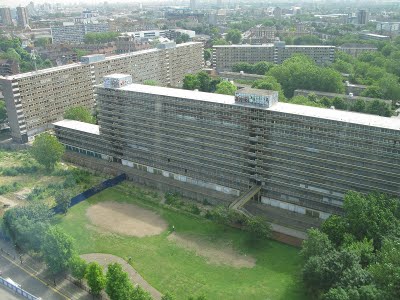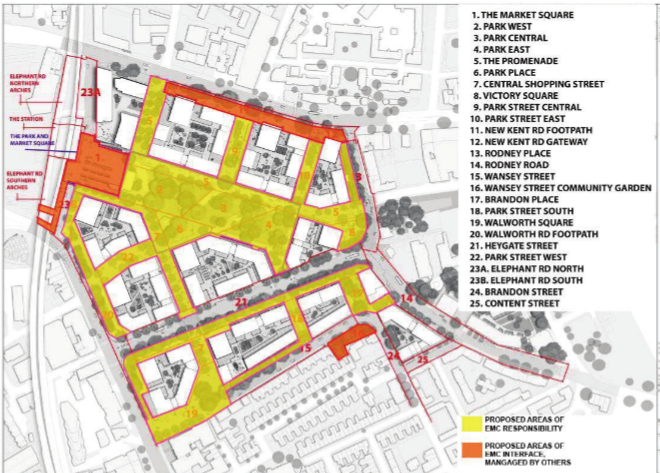
In 2006 the council removed this designation on the basis that “The space principally addresses the needs of Heygate residents and following the demolition of the estate there will no longer be a need for this type of estate-based facility” 2. The park was eventually closed in 2011 amidst fierce opposition from local residents. It was subsequently divided in two, with one half leased to the neighbouring Delancey ‘Tribeca Square’ development to be used as a compound and the other half to Lend Lease for use as a box park & sales showroom.
According to a 2002 audit by planning consultant Michael Parkes, the Heygate estate used to comprise a total 24,195 square metres of public amenity open space.
 Much fanfare has been made of Lend Lease’s plan to create central London’s largest park in more than 70 years’. However, according to Lend Lease’s planning application, the new park will be just 8,220 square metres in size - representing a net loss of more than two thirds of the site’s open amenity space. When probed during the Feb 2013 CPO public inquiry into the scheme, architect Ken Shuttleworth said the ‘largest park in 70 years’ claim is based in relation to the nearby Geraldine Harmsworth Park (Imperial War Museum), which received designation in 1934. We did a little research and found that the claim to being central London’s largest new park in 70 years is pure fiction and plainly ridiculous. In fact, it’s not even the largest new park in Southwark in 70 years - let alone central London: the following Southwark parks are all larger than the one proposed by Lend Lease (0.82H) and have all received open space designation since the Geraldine Harmsworth park was opened in 1934:
Much fanfare has been made of Lend Lease’s plan to create central London’s largest park in more than 70 years’. However, according to Lend Lease’s planning application, the new park will be just 8,220 square metres in size - representing a net loss of more than two thirds of the site’s open amenity space. When probed during the Feb 2013 CPO public inquiry into the scheme, architect Ken Shuttleworth said the ‘largest park in 70 years’ claim is based in relation to the nearby Geraldine Harmsworth Park (Imperial War Museum), which received designation in 1934. We did a little research and found that the claim to being central London’s largest new park in 70 years is pure fiction and plainly ridiculous. In fact, it’s not even the largest new park in Southwark in 70 years - let alone central London: the following Southwark parks are all larger than the one proposed by Lend Lease (0.82H) and have all received open space designation since the Geraldine Harmsworth park was opened in 1934:
*Potter's Field 1.35H
*Mint Street Park .92H
*Leathermarket Gardens 1.15H
*Tabard Gardens 1.75H
*Dickens Fields 1.20H
 The planning application documents also show that the Heygate’s new park will be just 42m wide (around the same width as New Kent rd), overshadowed by 12-30 storey buildings and hemmed in by a new road servicing the development’s 616 new car-parking spaces:
The planning application documents also show that the Heygate’s new park will be just 42m wide (around the same width as New Kent rd), overshadowed by 12-30 storey buildings and hemmed in by a new road servicing the development’s 616 new car-parking spaces:
This is a real kick in the teeth for local residents who can remember the promises of the original regeneration plans. These proposed a sizeable public park and public open space on the site of the Heygate as can be seen from the original masterplan illustrations:

Furthermore, the remaining green spaces on the development will consist of ‘raised courtyards’ enclosed between clusters of blocks, which will have zero public access:
But what is even more disconcerting is that the planning application’s ‘Estate Management Strategy’ statement states that the new park - and indeed the entire footprint of the development - is going to be privately owned and privately managed:
“The long term regeneration vision is founded on the core principles of place making and central to this is the effective management of the spaces around Plots in addition to effective Plot and building management.” (para. 10)
“It is likely that an umbrella Estate Management Company (EMC) will be created, with separate Plot Management Companies responsible for managing each Plot sitting under it. Each Plot will have its own Plot Management Company (PMC). Each PMC will be controlled by the leasehold owners of the new homes, the Registered Provider and the leasehold owners of the retail spaces within the Plot.” (para. 2.2)
“The Estate Management Company (EMC) will hold the land on a long leasehold basis from Lend Lease. The Estate Management Company shall be controlled by a main board of directors responsible for managing the company.” (para. 4)

The Estate Management Strategy appears to have quite clear ideas of how the behaviour of its residents will be monitored and controlled:
“Anti‐Social Behaviour Policy - The principles set out in the Anti‐Social Behaviour Policy will lay out common standards for the delivery of effective anti‐social behaviour services across the Estate, the Plots and as part of tenancy and leasehold management.” (para. 7.5)
“Security - The EMC and PMCs will have a key role in linking with local agencies, in particular the police, Southwark’s Anti‐Social Behaviour (ASB) services and the town centre security team and the local Community Safety teams.” (para. 8.2)
 Further reference to the proposed privatisation of the space is found in the Master Regeneration Plan: “To ensure that the high quality external environment is maintained the completed site will be managed by its own security, maintenance and cleaning service.” (para. 2.8)
Further reference to the proposed privatisation of the space is found in the Master Regeneration Plan: “To ensure that the high quality external environment is maintained the completed site will be managed by its own security, maintenance and cleaning service.” (para. 2.8)
We have been campaigning in vain to have what little open space there is in the new development formally adopted by the council. Unfortunately it looks like the new ‘Elephant Park’ is going to be yet another addition to London’s growing list of POPAS (Privately Owned Publicly Accessible Spaces).
-
Elephant Park was designated as Public Open Space (ref:A20) in the borough’s Unitary Development Plan↩
-
See paragraph 52 of this planning officer report↩

